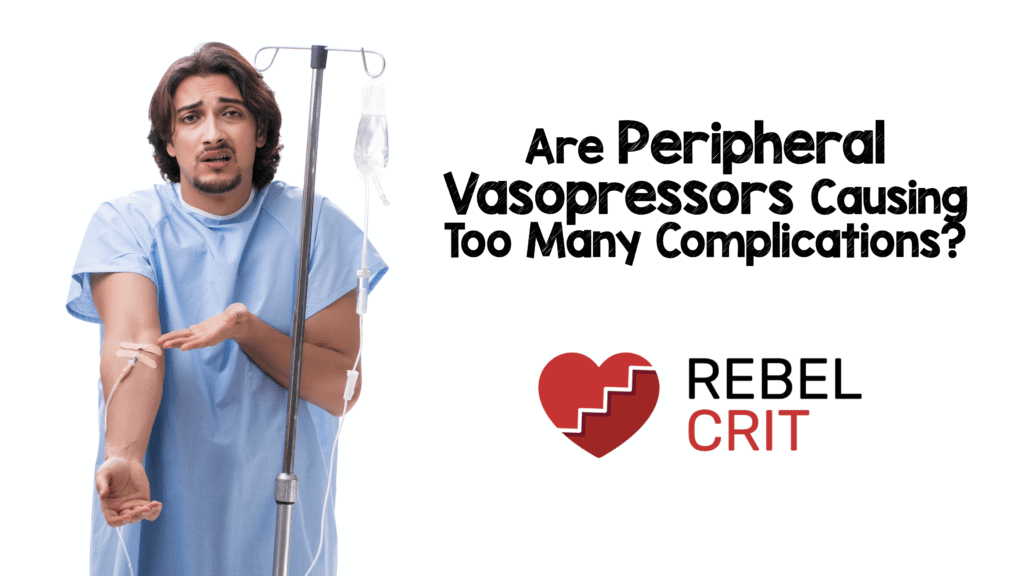

Paper: Tran et al. Complication of Vasopressor Infusion Through Peripheral Venous Catheter: A Systematic Review and Meta-analysis. Am J Emer Med. PMID: 33039229
Clinical Question: What is the prevalence of complications from infusing vasopressors through PIVs?
What They Did: Systematic review and meta-analysis to assess current literature about the prevalence of complications of vasopressor infusions via PIV. Studies included were prospective randomized control trials, quasi-randomized control trials, and observational prospective or retrospective studies of adult patients. Case reports were excluded. Vasopressors used in the studies were norepinephrine, epinephrine, phenylephrine, vasopressin, dopamine, terlipressin, and ephedrine
Outcomes:
- Primary: Any complication as a direct result of infusion at the longest time of follow up in the studies
- Complications were split into minor and major adverse events
- Minor: Extravasation, infiltration, cellulitis, and thrombophlebitis
- Major: Ischemic limb, tissue necrosis, and venous thrombosis
- Secondary:
- Any treatment for complications
- Treatment of complications included amputation, debridement, cold compression, hot compression, pain medication, observation, and local infiltration of phentolamine
- Any treatment for complications
Results:
- 9 studies included from the 325 studies identified
- 8 were observational studies
- 1 was a randomized control trial
- All studies were rated as moderate quality
- A total of 1835 patients were included in the studies
- The most common size of PIV was a 20-gauge catheter (56%)
- Norepinephrine was the most commonly used vasopressor (65%)
- The mean length of infusion was 25 hours (Range: 9.7 to 49hrs)
- Max rate of norepinephrine infusion was 0.13ug/kg/min
- There was a total of 122 (7%) events overall
- Of these, 117 (96%) were minor and 5 (4%) were major events
- The most common complication was infiltration (72%) followed by erythema (21%)
- All major events were peripheral venous thrombosis
- 5 studies reported no treatment necessary for adverse events but 2 studies used phentolamine and one study reported heat application
- Catheter size of 20-gauge or larger was associated with lower complication rates
- Catheter location and length of infusion was not correlated with complication rates
- A subgroup of studies reported the explicit use of safety guidelines for vasopressor infusion via PIV. These studies showed lower complication rates with these guidelines were in place
Strengths
- Included a large number of patients
- Evaluated studies using the most common vasopressors and PIV catheter sizes seen in clinical practice
- Looked for a wide array of complications
- Included studies were evaluated with an objective Newcastle-Ottawa Scale and Cochrane Risk of Bias tool
- Used a Kappa score to assess interrater agreement
- Divided complications into minor and major instead of lumping them all together
- Excluded case reports which cannot report true incidence of complications
- Studies included took place in the ED and ICU increasing generalizability to multiple settings
Limitations:
- High heterogeneity between studies due to different methodologies, different patient populations and clinical settings
- In a meta-analysis, the quality of studies included determines the quality of conclusions reached
- An increased risk of bias due to only one study using objective measurements to assess infiltrations and other types of complications
- Only one RCT, so a meta-analysis could not be performed to compare peripheral IVs vs CVCs
- No meta regressions could be performed on maximum concentrations of vasopressors as many studies reported non-weight-based dosing
Discussion:
- As has been previously shown, delay in initiation of vasopressors has been associated with increased mortality. Placement of CVCs is a time-consuming procedure, but infusion of vasopressors through PIV has been met with some resistance due to uncertain complication rates. This study demonstrated that infusing vasopressors through PIVs is a safe alternative to CVCs.
- Studies published between 2016 to 2020 (i.e. newer studies) had a trend toward significantly lower prevalence of complications compared to studies published prior to these dates (5% vs 10 to 25%). This is most likely learning from previous evidence and more use of US-guided PIVs. In all these studies vasopressor infusion was <24 hours
- An important point is that studies explicitly reporting an observation protocol/safety protocol were associated with a significantly lower prevalence of complications than studies that didn’t (3% vs 12%)
- Studies included were of varying size, ranging from 20 up to 953 patients. Studies with >250 patients also had lower prevalence of complication rates compared to studies with <250 patients (3% vs 9 to 18%). This is why smaller studies tend to overestimate benefit or harm when there is not enough patients enrolled
Author Conclusion: “There was low prevalence of complications as a direct result from infusing vasopressors through PIVs. Studies with safety guidelines were associated with significantly lower prevalence of complications. Further studies are needed to confirm our observations.”
Clinical Take Home Point: Infusion of vasopressors through PIV is a safe practice with an overall complication rate of 7%. The majority of these complications are minor in nature (i.e. Extravasation, infiltration, cellulitis, and thrombophlebitis). If infusing vasopressors through a PIV a safety/observation/extravasation guideline should be established as this associated with significantly lower incidence of adverse events.
References:
- Tran et al. Complication of Vasopressor Infusion Through Peripheral Venous Catheter: A Systematic Review and Meta-analysis. Am J Emer Med. PMID: 33039229
- Beck et al. Timing of Vasopressor Initiation and Mortality in Septic Shock: A Cohort Study. Crit Care 2014. PMID: 24887489
For More Thoughts on This Topic Checkout:
Post Peer Reviewed By: Salim R. Rezaie, MD (Twitter: @srrezaie)
The post Are Peripheral Vasopressors Causing Too Many Complications? appeared first on REBEL EM - Emergency Medicine Blog.
